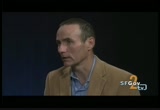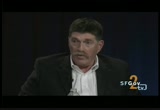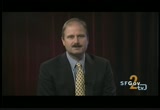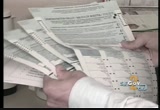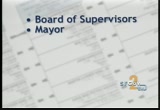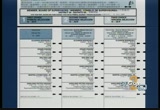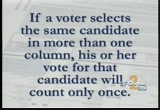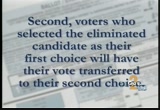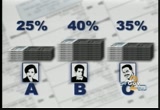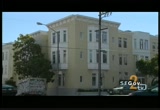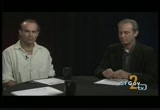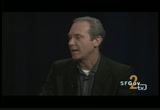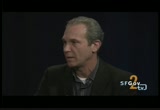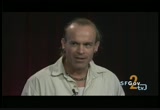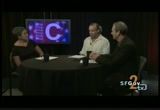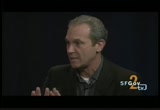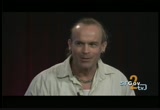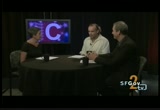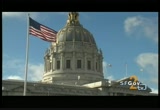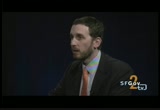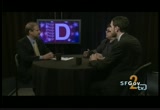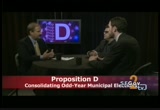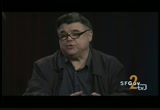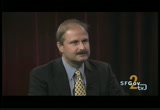tv [untitled] October 9, 2012 5:00pm-5:30pm PDT
5:00 pm
been completed yet for sites like like merced, so it's not possible, it's not legally possible, to specify exactly how that money would get spent on that particular site. we know there's a lot of habitat restoration work that's needed at like merced, there's trail work that's needed, there's recreation facility renovations that are needed. there's a lot of different needs in like merced that have built up over time and so the city will use this community engagement process to determine what's the best way to use that, once the bond passes ?oo ?a okay, thank you. so we have a little bit of time left so i'd like closing comments by both of you. thank you. >> well, i just want to follow-up on what he said. how interesting since 99 million dollars of the bond is ceqa approved? categorical exemption. so they are getting categorical exemptions through ceqa right now and what this leads to is complete lying to
5:01 pm
the voter. for example, when you go to golden gate park, beach solis, that was listed simply aiz categorical exemption for a field. all of a sudden you have a soccer stadium out of nowhere that the voters were never told about where they are going to change grass into turf i think a lot of this is very disingenuous and i think it's why neighborhoods are tired of rec and park. >> first, there's no soccer stadium. this bond is about current and future san franciscoans, especially our kids. this bond would pay for renovation of play grounds all across the city that are failing. it will pay for
5:02 pm
renovation of swim pools that are many years old and in threat of being closed because of their physical condition. it will pay for trail maintenance, tree maintenance, improving and cleaning up toxic pollution along the city's eastern waterfront and a wide array of positive vital investments in our park system to help maintain that no. 1 rating for us and for future generations. >> thank you, gentlemen. we hope that this discussion was informative. for more information on this and other ballot measures in this year's election, please visit the san francisco league of women voters vote at sfvotes.org. remember, early voting is available at city hall monday through friday from 8:00 am to 5:00 pm if you don't vote early, be sure to
5:03 pm
♪ >> hello, and welcome to the department of elections right choice voting instructional video. it is part of the department of elections right choice voting outreach campaign and is designed to educate san francisco rig franciscoht choice voting. today we will learn what it is and who is elected using this voting method. we will also talk about with the ranked joyce l. looks like and how to market correctly. finally, we will see how the ranked joyce voting process works and to you an example of an election using ranked choice of voting. so, what is ranked joyce voting? in march 2002 san francisco voters adopted a charter to implement ranked choice of voting, also known as instant runoff voting. san francisco voters will use it
5:04 pm
to elect most local officials by selecting a first choice candidate in the first column on the ballot and deborah second and third choice candidates in the second and third columns resect to do -- respectively. this makes it possible to elect local officials with the majority of votes. more than 50% without the need for a second runoff election. in san francisco, ranked choice of voting is for the election of members of the board of supervisors, the mayor, sharon, just -- district attorney, city attorney, treasurer, this is a recorder, and public defender. ranked joyce voting does not apply to elections for local school and community college board members. number the election of state or federal officials. ranked choice of voting does not affect the adoption ballot measures. when voters received their ballot, either at a polling
5:05 pm
place or an absentee ballot in the mail, it will consist of multiple cards. voters will receive cards with contests for federal and state offices, as well as for state propositions and local ballot measures. for ranked choice voting contest, voters will receive a separate ranked choice ballot card. it will have instructions to rank three choices, which is new. the ranked choice ballot is designed in the side by side column format that lists the names of all candidates in each of the three columns. when marking the ranked choice ballot, voters elect their first choice in the first column by completing the aero pointing to their choice. for their second choice, voters selected different wind by completing the arab pointing to their choice in the second column. for their third choice, voters elect a different candidate by completing the arrow pointing to
5:06 pm
their choice. voters wishing to vote for qualified write-in candidate can write it in on the line provided. and they must complete the arrow pointing to their choice. keep in mind, it voters should select a different candidate for each of the three columns of the ranked choice ballot card. if the voters elect the same candidate in more than one column, his or her vote for that candidate will count only once. also, a voter's second choice will be counted only if his or her first choice candidate has been eliminated. and a voter's third choice will be counted only if both his or her first and second choice candidates have been eliminated. we have talked about how to mark the ranked choice ballot. now let's look at how ranked choice of voting works. initially, every first choice vote is a candidate.
5:07 pm
any candidate that receives a majority, more than 50% of the first choice to vote, is determined to be the winner. if no candidate receives more than 50% of the first choice votes, a process of eliminating candidates and transferring votes begins. first, the candidate who received the fewest numbers of first choice votes is eliminated from the race. second, voters who selected the eliminated candidate as their first choice will have their vote to transfer to their second choice. there, all the votes are recounted. fourth, if any candidate receives more than 50% of the votes, he/she is declared the winner. if no candidate receives more than 50% of the vote, the process of eliminating candidates and transferring votes is repeated until one candidate has a winning majority. now let's look at an example of
5:08 pm
an election using ranked choice of voting. in this example, we have three candidates. candidate a, b, and c. after all the first choice votes are counted, none of the three candidates has received more than 50%, or a majority of the first choice vote cast. candidate a g-205% ofb the votes% received 40%. and c received 35% of the boats. because no candidate received a majority, the candidate who received the fewest number of first choice votes, a candidate a, is eliminated from the race. voters to pick a candidate a as their first choice candidate will have their but transferred to their second choice. and the voters to pick and a, 15% chose candidate b as their second choice, and 10% chose c as their second choice. these votes are then applied to
5:09 pm
b and c, and the votes are recounted. candidate b now has 55% of the votes. candidate c as 45%. candidate b has more than 50% of the votes and is determined as the winner. >> thank you for watching. we hope you have ranked choice learned ranked choice of voting and was elected. you have seen the ballot, learned how to market, and learned how the voting process works. if you have any further questions about ranked choice voting, please contact us at department of elections, city hall, room 48, 1 dr. carlton be good lit place, sentences go, california, 94102. or 415-554-4375. visit our website, www.sfelections.org.
5:10 pm
hi, i'm jay konig, a member of the league of women voters. along with the league and sf gov tv, i'm here to discuss proposition c the city currently uses federal, state and local funds to support affordable housing programs for both low income and moderate income households. recent federal cutbacks and reductions in state funding have decreased the funding available for affordable housing programs. proposition c would amend the charter to establish a housing trust fund. the city would contribute $20 million dollars to the fund in 2013. each year the city contribution would increase by
5:11 pm
2.8 million dollars up to 50.8 million dollars in 2024. after 2024, the city would contribute an annual amount base the on the 50.8 million dollars but adjusted for changes in the city's general fund revenue. the city would use the fund to build, purchase and improve affordable housing, provide 15 million dollars for a loan program for down payment assistance for moderate income home buyers and emergency first responders and provide up to 15 million dollars for a program that would help eligible households avoid foreclosure. proposition c would change the affordable housing requirement for private residential developments in two ways. first, it would reduce the on site affordable housing requirement to approximately 12 percent for most projects. second, it would prohibit the
5:12 pm
city from increasing affordable housing requirements beyond those in place on january 1st, 2013. proposition c would authorize the development of up to 30,000 low income rental units in the city. i'm here with peter cohen, executive director of the council of community housing organizations, and a proponent of proposition c also joining us is starchild, local activist with the libertarian party of san francisco and former candidate for public office. he is an opponent of the measure. thank you both for taking the time to be with us day. peter, would you offer some opening comments about your support of the measure? >> sure, and thank you, jay, for having us and for the league of women voters for puting this on. this is a great service. i don't want to overcomplicate this. the prop c housing trust fund is really a very basic
5:13 pm
measure. it maintains and stabilizes the long-standing funding committee san francisco has made to affordable housing. just in the last two decades the city has helped it produce upwards of 20,000 permanently affordable housing units, boat both rental and home ownership. the state of california recently dissolved our redevelopment agencies across the state for various reasons, but one of the unintended consequences was that it eliminated one of the great funding sources for our affordable housing work locally. prop c restores that source essentially to the same level and continue to provide that long-standing commitment. >> thank you. starchild, can you offer some comments for the opposition? >> sure, and thank you again for having us.
5:14 pm
proposition c would actually subsidize housing for people earning more than the median income in san francisco among others and would reduce the amount of units in new development which go to so-called affordable housing, which isn't really even all that affordable. san francisco desperately needs more afrldable housing but this mer err, which essentially brings the san francisco redevelopment agency back from the dead, is not the way to do it. the redevelopment agency has a long history some would say of racism and certainly cronyism, lack of accountability, that's one of the reasons they were closed down last year by the democratic governor. we believe that was a great decision and shouldn't be brought back until 2042. >> peter, similar elements
5:15 pm
what we're seeing in this proposition almost four times, set asides in 9090 and the bond measures proposed in 2002 and 2004. can you describe how this may be different in its effect in how it's being brought forward to the voters? >> sure. well, as i said, the immediate context, the crisis, if you will, is that the city stands to significantly lose funding for its programs. i mean we're talking about a program cut. so that's quite different in some respects from previous attempts, but the similarity is that for many years we've been thinking about how to stabilize the funding that we need for affordable housing programs over the long-term. not everything can be done immediately, sometimes there needs to be long-term planning, there needs to be bonding, it's a complicated process of doing affordable housing work. the way it was done before if
5:16 pm
a bond was previously passed was to get the voters to approve a bond, you essentially are borrowing money, you spend that down, you pay it back with interest and start over again. the idea of having a somewhat more stable and permanent source is the housing trust fund. the difference between this and the previous attempt is it does not touch previous revenues existing now. it builds on existing sources and new sources that are anticipated. that's a very important point for us coming into this. we have many members, i have a coalition, the council of community housing coalition is a coalition of developers and organizers and none of them are in social services. we understand full well you can't rob from peter to pay paul. that was one of our fundamental, if you will, bright lines was that it have revenue that did not touch
5:17 pm
funding from other sources. >> the opposition. starchild. >> money is fungible so any money put toward this source would by definition not be available for other needs, everything from parks to health care to education. this measure would get san francisco city government into the business of making home loans. this is part of what brought on the economic crisis at the federal level, fannie mae and freddie mac giving out home loans to people who couldn't afford to buy and later had their houses foreclosed. we don't know what's going to happen in the housing market for the next 30 years. i think it's foolish to set aside increasing set amounts of money for the next 3 decades when we know right now that there's thousands of people living on the streets. why not just build as many affordable units
5:18 pm
now as possible and do that by getting government out of the way with all its red tape and regulations and taxes and union work rules that increase the cost of housing. that would be a better way to get affordable housing, not bringing back this redevelopment agency with its legacy of driving african americans out of the fillmore and they had slated more than half the bay area for redevelopment before they were shut down. >> anything you'd like to add, peter? >> there's a number of assertions from my opponent that are based in a misunderstanding how affordable housing works in san francisco in this particular measure. unfortunately there's not enough time to tackle all of them, but i want to make clear this is not subsidizing middle income home owners. this is going to go primarily for low and very low householders in
5:19 pm
san francisco. that has always been the programmatic focus because you can leverage funding. we live in a high income market and that is exactly why we have an affordable sector in this city. when it comes it recreating redevelopment, that's a fallacy. it's about recognizing that redevelopment allowed a certain portion of money to be used for redevelopment. it's not about recreating redevelopment, in fact that's a closed chapter in history. lastly the idea we are reducing the mixed income housing is also a sort of fallacy. there is a purpose to providing an incentive for developers to do what's called mixed income housing, providing some of their units are affordable to mixed income households. most developers do not do that and this is an
5:20 pm
incentive for them to do it. this is providing a set of programs that are funded providing all the way for folks who were formerly homeless to folks who are middle income to be and stay in san francisco. >> any final comments, starchild. >> it sounds like peter is saying on one hand, well, no, it won't subsidize middle income people then he's saying there is a range all the way from middle income people all the way up to -- he doesn't say what the top range is. there's a guy named jim reid who is a contractor here he built himself in his own back yard a single unit house that he built for $12,000, very small, designed for one person, getting somebody off the street, like 10 foot by 10 foot but it had plumbing, electricity, storage, everything someone would need to live a simple existence.
5:21 pm
12,000, how much is it going to cost to build these, half a million dollars? they are not really affordable. they're not going to help those most in need of housing as we can see by the continued presence of the homeless on the streets of san francisco. this is a measure designed to capture revenue like the redevelopment agency did. >> thank you both very much for sharing your thoughts and insights. we hope this discussion was informative. for more information on this and other ballot measures in this year's election, please visit the san francisco league of women voters web site at sfvotes.org and remember early voting is available at city hall monday through friday from 8:00 am to 5:00 pm if you don't vote early , be sure to vote on november 6. thank you.
5:22 pm
. >> hi, i'm richard janning, a board member of the league of women voters. along with the league and sf gof tv, i'm here to discuss proposition d, a ballot measure that will be before the voters on november 6. the mayor, sheriff and district attorney are elected in november of the same year. the city attorney and treasurer are elected in november of a different year. proposition d is a charter amendment that would change the election cycle for city attorney and treasurer so that these officers would be elected at the same time as the mayor, sheriff and district attorney beginning in 2015. i'm here with district 8 supervisor scott weiner, and
5:23 pm
dr. scott fauker, an opponent of proposition d >> let's start with you, supervisor. thanks for having me. proposition d is a good government measure that will increase voter turnout in our elections for city attorney and treasurer, two very important offices, and will also save the city 4.2 million dollars every 4 years. right now we elect our city attorney and treasurer in a very, very low turnout odd year election where they are the only two offices on the ballot. and turnout is always extremely low in that election. and it costs us over $4 million dollars to hold that election. proposition d would move the city attorney and treasurer elections to be on the same ballot as the mayor, which is a much myer turn jut election, so
5:24 pm
more people would be voting for city attorney and treasurer and every time we don't hold that very low turnout odd year election separately for city attorney and treasurer, we'll save 4.2 million dollars. prop d was put on the ballot unanimously by the board of supervisors and it's been endorsed overwhelmingly by both the democratic and republican party. >> dr. faulkner, do you think this is a good idea. >> it has several problems. the original theory is the charter of 1932 was to stagger elections so people would pay more attention to each office, in other words, elect a couple offices each time and do it on an annual basis. this has been modified with various charter amendments but the new charter but the other way theoretically you have more people involved, but in practice when you have those 3-page ballots printed on either side, offices get lost. things like city attorney and city treasurer will get lost in
5:25 pm
the shuffle. the big problem is city government, making sure the people actually pay attention. we have had a problem for a long time with san francisco and dysfunctional san francisco. that's depending on other city issues that are up, the coalition to san francisco neighborhoods is going against them. we have a city government that's very out of touch in many ways and we're, frankly, annual elections would be very wise to keep the people paying attention it what's happened. we have very strong developer interest, strong lobbyist influence, and very little public interest. things get sidelined and they wonder why things suddenly get opposed like the park bond which is being heavily opposeopposed. >> thank you.
5:26 pm
supervisor, do you believe having the elections all at one time is better for the electorate or does it get lost when you have so many positions up for election? >> since he did raise the issue of the parks bond, we're not here for that. the parks bond has very overwhelming support. going back to prop d, there's a balance to be struck. i agree if we only had, if we elected everything from president to dog catcher all on 1 ticket at some point it gets to be too much, but if you spread everything out too much, we could have separate elections for like two offices here, two offices there and have multiple elections every year. yes, that would give more air time to each individual election but no one would vote and you'd have extremely low turn out elections. so for the city attorney-treasurer elections at issue here, even though they have higher prominence in their stand alone odd year election, when only 15, 20 percent, maybe
5:27 pm
25 percent in a good year, are actually voting in that election, what's the point? more prominence but no one's actually voting for it. a bad turnout for a mayoral election is better than a good turnout for city attorney-treasurer stand alone election. so combining those elections gives a bad balance in terms of increasing voter participation and improving our budget situation. >> thank you. dr. faulkner, if we don't have good voter turnout for the odd year for the city treasurer position, why not combine it with the rest? >> as i said, annual elections at least keep people paying attention. the history of san francisco, which is not a good one, we have had a lot of corruption over the years, russ baldwin, the roof ring, the history of san francisco is pretty open. we have had a tremendous amount of developer
5:28 pm
influence at city hall, a tremendous amount of lobbying, the people are pushed out of it. we need more public participation. originally odd elections were scheduled for the mayor's race, we do not schedule it with the president for that reason. with the first repeal of district elections the people who did the first repeal suddenly moved it over to presidential and gubenatorial elections and changed the pattern. >> dr. faulkner, excuse me for a second. i'm trying to get back to the point here. if we don't feel there's sufficient voter turnout in the treasurer cycle, why not put it with the all the rest. >> first of all we usually have other measures up at the same time including ballot
5:29 pm
measures, bonds and all the rest. usually those annual elections are important. often they are combined with stake wide elections anyway. the 4 million he is talking about is an illusion because we frequently have special elections for the state as well. that's a very persistent thing under schwarzenegger and a lot of people. >> supervisor, we have a little time left and i would like you to conclude and give your opinion why you think we should be voting for this. >> in 2001 we elected city attorney and treasurer in an election that had i think something like 12 or 13 percent turnout. these are two very, very important positions, we should maximize turnout. i think it makes perfect sense to elect these positions with the mayor. i can't tell you how many people after i proposed this at the board of supervisors, paepl on the board, off the board, came up to me and said why didn't anyone think of this
136 Views
IN COLLECTIONS
SFGTV2: San Francisco Government Television Television Archive
Television Archive  Television Archive News Search Service
Television Archive News Search Service 
Uploaded by TV Archive on

 Live Music Archive
Live Music Archive Librivox Free Audio
Librivox Free Audio Metropolitan Museum
Metropolitan Museum Cleveland Museum of Art
Cleveland Museum of Art Internet Arcade
Internet Arcade Console Living Room
Console Living Room Books to Borrow
Books to Borrow Open Library
Open Library TV News
TV News Understanding 9/11
Understanding 9/11